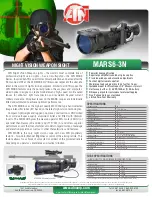
15
6. Care and Maintenance
If you give your telescope reasonable care, it will
last a life-time. Store it in a clean, dry, dust-free
place, safe from rapid changes in temperature and
humidity. Do not store the telescope outdoors,
although storage in a garage or shed is OK. Small
components like eyepieces and other accessories
should be kept in a protective box or storage case.
Keep the cap on the front of the telescope when it is
not in use. The telescope requires very little
mechanical maintenance. The optical tube is steel
and has a smooth painted finish that is fairly scratch
-resistant. If a scratch does appear on the tube, it
will not harm the telescope. If you wish, you may
apply some auto touch-up paint to the scratch.
Smudges on the tube can be wiped off with a soft
cloth and a household cleaner such as Windex or
similar.
Cleaning Lenses
Any quality optical lens cleaning tissue and optical
lens cleaning fluid specifically designed for multi-
coated optics can be used to clean the exposed
lenses of your eyepieces or finderscope. Before
cleaning with fluid and tissue, blow any loose
particles off the lens with a blower. Then apply some
cleaning fluid to a tissue, never directly on the
optics. Wipe the lens gently in a circular motion,
then remove any excess fluid with a fresh lens
tissue. Oily fingerprints and smudges may be
removed using this method. Use caution; rubbing
too hard may scratch the lens. On larger lenses,
clean only a small area at a time, using a fresh lens
tissue on each area. Never reuse tissues.
Cleaning Mirrors
You should not have to clean the telescope’s mirrors
very often; normally once every year or so. Covering
the telescope with the dust cap when it is not in use
will prevent dust from accumulating on the mirrors.
Improper cleaning can scratch mirror coatings, so
the fewer times you have to clean the mirrors, the
better. Small specks of dust or flecks of paint have
virtually no effect on the visual performance of the
telescope. The large primary mirror and the elliptical
secondary mirror of your telescope are front-surface
aluminized and over-coated with hard silicon
monoxide, which prevents the aluminum from
oxidizing. These coatings normally last through
many years of use before requiring re-coating (which
is easily done). To clean the secondary mirror, first
remove it from the telescope. Do this by keeping the
secondary mirror holder stationary with your fingers
while unthreading the center Phillips head screw in
the hub of the 4-vaned spider. The entire mirror
holder will come out of the telescope. The secondary
mirror itself cannot be removed from the holder
because it is glued into place. Handle the entire
assembly carefully by the holder only; do not touch
the mirror surface. You can clean the secondary
mirror in its holder by following the same procedure
described below for cleaning the primary mirror.
To clean the primary mirror, carefully remove the
mirror cell from the telescope. This is done by
removing the six screws that connect the entire
mirror cell to the steel tube. These screws are
located on the outside of the tube, just above the
mirror cell casting.
Now, remove the mirror from the mirror cell by first
removing the four mirror clips that secure the
mirror in its cell. Use a Phillips screwdriver to
unthread the mirror clip anchor screws. Next, hold
the mirror by its edge, and remove it from the mirror
cell. Be careful not to touch the aluminized surface
of the mirror with your fingers! Set the mirror on a
clean, soft towel. Fill a clean sink, free of abrasive
cleanser, with room-temperature water, a few drops
of liquid dishwashing detergent, and if possible,
a cap-full of isopropyl alcohol. Submerge the mirror
(aluminized face up) in the water and let it soak
for several minutes (or hours if it’s a very dirty
mirror). Wipe the mirror under water with clean
cotton balls, using no downward pressure and
stroking in straight lines across the surface.
Use one ball for each wipe across the mirror. Then
rinse the mirror under a stream of lukewarm water.
And a final rinse with distilled water.
Dry the mirror in a stream of air (a “blower bulb”
works great), or remove any stray drops of water
with a Q-Tip. Water will run off a clean surface.
Dry the bottom and edge surfaces with a towel (Not
the mirror surface!). Once the mirror is completely
dry it is ready for reassembling the telescope,
which is the reverse of what you have just done
If you have any questions ring Bintel Customer
Support on
(02) 95187255 or (03) 98220033
7. Specifications BT 152 / BT 202
Bintel BT 152:
Focal Length: 1200mm
Aperture: 152mm
Focal Ratio: f/7.9
Mirror Coatings: Aluminum with SiO2 overcoat.
Minor Axis of Secondary Mirror: 47.0mm
Weight: 19.5kg.
Tube Length: 1181mm
Tube Outer Diameter: 176mm
Focuser: 1.25" Crayford design .
Eyepieces: 25mm & 9mm Bintel Plössl,1.25" barrel
diameter, ND #96 Filter
Magnification: 48x & 133x
Finder Scope: 6 x power, 30mm aperture
Finder bracket: Dovetail base, spring-loaded X-Y
alignment
Bintel BT 202:
Focal Length: 1200mm
Aperture: 203mm
Focal Ratio: f/5.9
Mirror Coatings: Aluminum with SiO 2 overcoat.
Minor Axis of Secondary Mirror: 47.0mm
Weight: 25kg.
Tube Length: 1181mm
Tube Outer Diameter: 235mm
Focuser: 2" Crayford design with 1.25"adapter.
Eyepieces: 30mm Superview (2”), 15mm & 9mm
Bintel Plössl, fully coated with multi-coatings, 1.25"
barrel diameter
Magnification: 46X, 80x & 133x
Finder Scope: 8x power, 50mm aperture, Achromat
Finder bracket: Dovetail base, spring-loaded X-Y
alignment
Cooling fan with Battery Pack


































